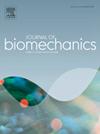Neural networks can accurately identify individual runners from their foot kinematics, but fail to predict their running performance
IF 2.4
3区 医学
Q3 BIOPHYSICS
引用次数: 0
Abstract
Athletes and coaches may seek to improve running performance through adjustments to running form. Running form refers to the biomechanical characteristics of a runner’s movement, and can distinguish individual runners as well as groups of runners, such as long-distance and short-distance runners. Yet, in long-distance running it is still unclear whether certain running forms lead to better performance. In this study, we used a neural network to test the extent to which individual running forms, measured from foot kinematics, exist within long-distance runners and whether running forms can predict performance. To accomplish this goal, 119 participants ran on a treadmill at three different speeds and overground at a self-selected sub- maximal speed while we collected data from insole-embedded Inertial Measurement Units (IMUs) mounted in both shoes. Participants reported their personal best 10 km run times. We used these data to train the neural network to identify individual runners from their running data. Then, we trained the same neural network architecture to predict the runners’ performance. With enough data, the neural network was successful in identifying individual runners, but was comparable to a random coin flip (57 % accuracy) in predicting whether an individual runner is slow or fast. We interpret the success of the model to identify runners, but the subsequent failure of the same model to predict running performance as evidence that individual running form measured from foot kinematics contains insufficient information about a runner’s performance.
神经网络可从脚部运动学角度准确识别跑步者,但无法预测其跑步成绩
运动员和教练员可以通过调整跑步姿势来提高跑步成绩。跑步姿势指的是跑步者运动的生物力学特征,可以区分个体跑步者和群体跑步者,如长跑者和短跑者。然而,在长跑中,某些跑姿是否能带来更好的成绩仍不清楚。在本研究中,我们利用神经网络测试了长跑运动员中根据脚部运动学测量的个体跑步形式的存在程度,以及跑步形式是否能预测成绩。为了实现这一目标,119 名参与者在跑步机上以三种不同的速度跑步,并在地面上以自选的次最大速度跑步,同时我们收集了安装在两只鞋内的鞋垫嵌入式惯性测量单元(IMU)的数据。参与者报告了他们的个人最佳 10 公里跑步时间。我们利用这些数据训练神经网络,以便从他们的跑步数据中识别出个别跑步者。然后,我们训练相同的神经网络架构来预测跑步者的成绩。在有足够数据的情况下,神经网络成功地识别了个别选手,但在预测个别选手是慢还是快方面,其准确率与随机投掷硬币相当(57%)。我们认为,该模型成功识别了跑步者,但随后该模型却无法预测跑步成绩,这证明根据脚部运动学测量的个人跑步形态没有包含有关跑步者成绩的足够信息。
本文章由计算机程序翻译,如有差异,请以英文原文为准。
求助全文
约1分钟内获得全文
求助全文
来源期刊

Journal of biomechanics
生物-工程:生物医学
CiteScore
5.10
自引率
4.20%
发文量
345
审稿时长
1 months
期刊介绍:
The Journal of Biomechanics publishes reports of original and substantial findings using the principles of mechanics to explore biological problems. Analytical, as well as experimental papers may be submitted, and the journal accepts original articles, surveys and perspective articles (usually by Editorial invitation only), book reviews and letters to the Editor. The criteria for acceptance of manuscripts include excellence, novelty, significance, clarity, conciseness and interest to the readership.
Papers published in the journal may cover a wide range of topics in biomechanics, including, but not limited to:
-Fundamental Topics - Biomechanics of the musculoskeletal, cardiovascular, and respiratory systems, mechanics of hard and soft tissues, biofluid mechanics, mechanics of prostheses and implant-tissue interfaces, mechanics of cells.
-Cardiovascular and Respiratory Biomechanics - Mechanics of blood-flow, air-flow, mechanics of the soft tissues, flow-tissue or flow-prosthesis interactions.
-Cell Biomechanics - Biomechanic analyses of cells, membranes and sub-cellular structures; the relationship of the mechanical environment to cell and tissue response.
-Dental Biomechanics - Design and analysis of dental tissues and prostheses, mechanics of chewing.
-Functional Tissue Engineering - The role of biomechanical factors in engineered tissue replacements and regenerative medicine.
-Injury Biomechanics - Mechanics of impact and trauma, dynamics of man-machine interaction.
-Molecular Biomechanics - Mechanical analyses of biomolecules.
-Orthopedic Biomechanics - Mechanics of fracture and fracture fixation, mechanics of implants and implant fixation, mechanics of bones and joints, wear of natural and artificial joints.
-Rehabilitation Biomechanics - Analyses of gait, mechanics of prosthetics and orthotics.
-Sports Biomechanics - Mechanical analyses of sports performance.
 求助内容:
求助内容: 应助结果提醒方式:
应助结果提醒方式:


